The Old English Sheepdog is a large, athletic dog breed with an unmistakable shaggy coat. The OES, as fans call the breed for short, was historically a drover, helping farmers drive cattle and sheep to the market. Today, this good-natured dog enjoys the comfort of home life and still competes in conformation, obedience, agility, and herding trials.
Even though these are purebred dogs, you may find them in the care of shelters or rescue groups. Remember to adopt! Don’t shop if you want to bring a dog home.
The OES is an adaptable, intelligent dog with an easygoing disposition. They’re affectionate with all members of their families, and despite the fact that they are large dogs, they can fit in well with apartment life so long as they get enough exercise from walks and play sessions. Their shaggy coats also don’t tend to shed as much as you might think. If you’re looking for a loyal, protective, and loving family companion, this may be the breed for you!
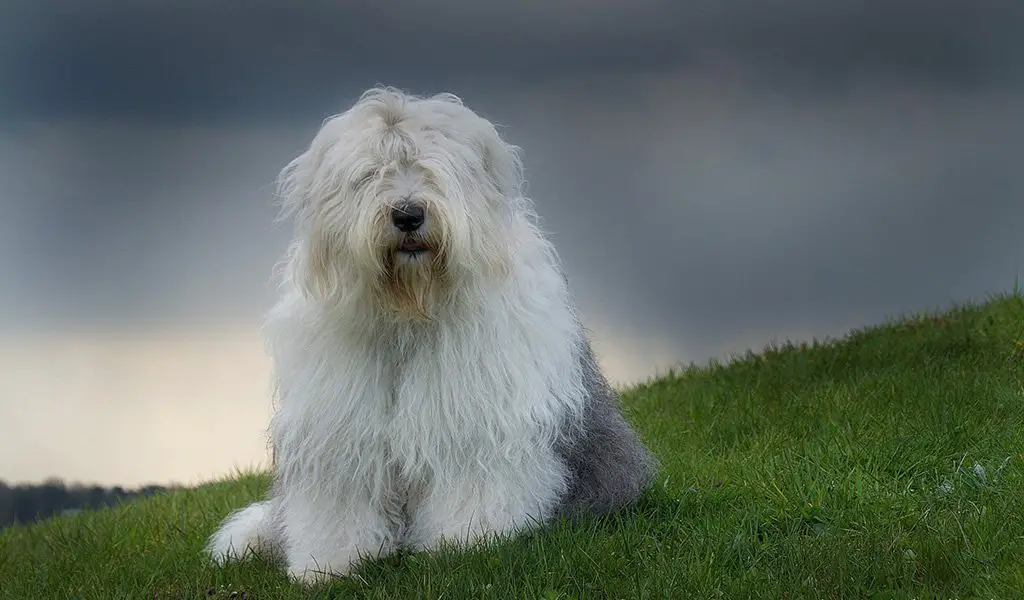
The wonderfully shaggy Old English Sheepdog is a favorite in children’s television shows and movies, where he’s usually affable, if sometimes bumbling, character. But, hair and Hollywood glitz aside, who is the OES?
In reality, the OES — nicknamed “Bobtail” because of his docked tail (traditionally kept short to identify him as a drover) — is an easygoing, fun-loving, intelligent dog. He’s a member of the American Kennel Club Herding Group. He’s certainly a large dog at 60 to 100 pounds, but his profuse coat of blue-gray and white makes him appear even larger. Known for his wonderful temperament, he’s powerful, sturdy, and hardworking.
Those who know and love him are familiar with his sense of humor. He can be playful and comical, although he is also the guardian and protector of his family.
You can’t talk about the OES without talking about hair, a lot of hair. This coat needs more care than most. It’s long and prone to matting if not regularly brushed. Many owners clip the hair short — but if he is to be a show dog, the OES cannot be trimmed short.
Expect three to four hours of grooming per week — perhaps more — plus monthly visits to a grooming salon. Not surprisingly, a common reason that OES owners surrender their dogs to rescue organizations is because of the time and cost of caring for the coat. Anyone considering this breed must think long and hard about grooming and related care.
The OES is highly adaptable. To some people’s surprise, he does well in an apartment if he is exercised regularly. In spite of his working heritage, he is not a good candidate for a backyard dog. He wants to be and should be, with his family, and he can suffer from separation anxiety if left alone too long. He is trainable and responds well to a firm owner who is kind and consistent. He gets along well with other dogs and pets.
With his shaggy coat, keen mind, and bobbed tail, the OES is a great addition to any family with the time and patience to care for him.
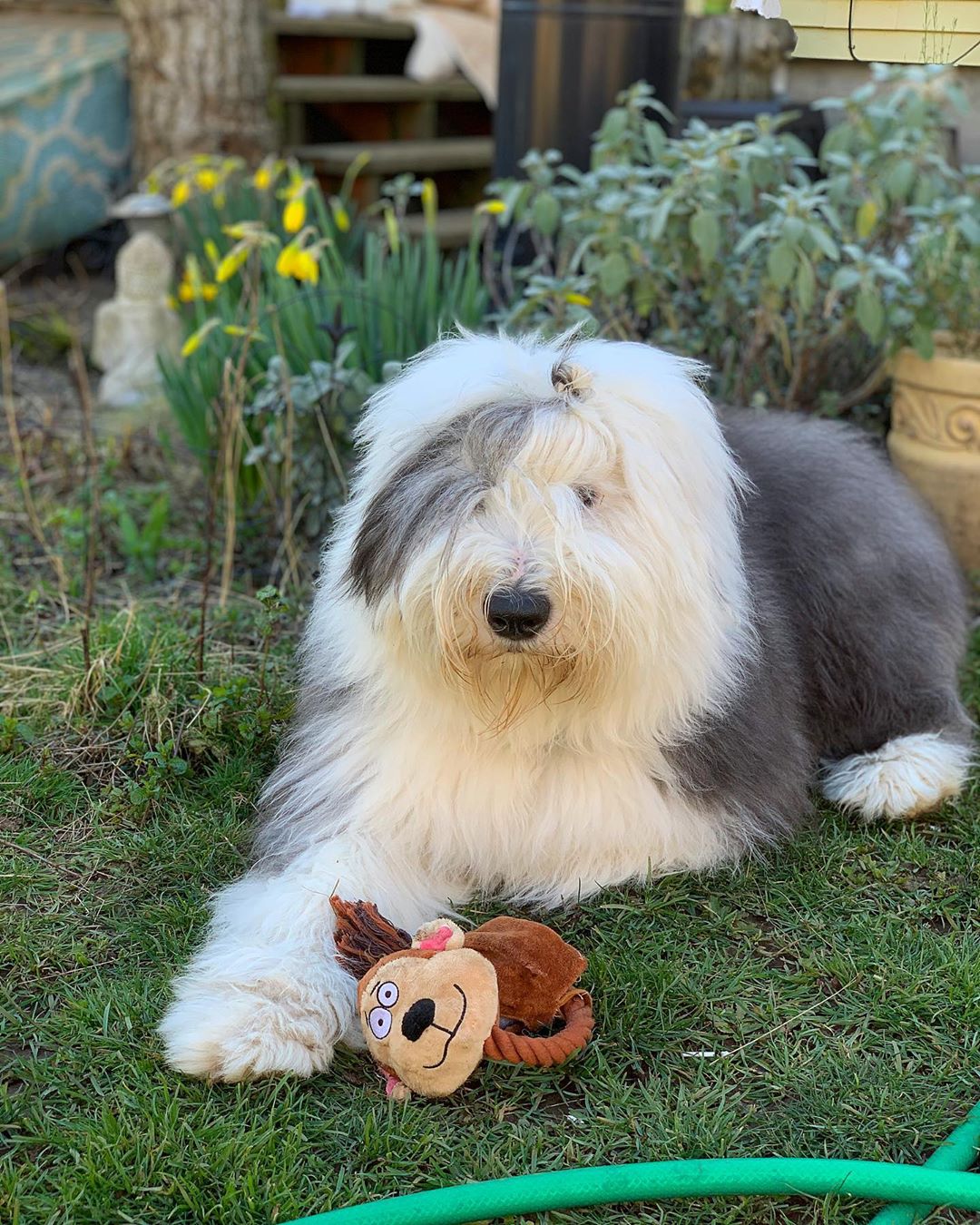
- Training and proper socialization are essential for Old English Sheepdogs. They are large, bouncy, and enthusiastic, but when they are young they can be especially rowdy. Patient, consistent training is a must.
- Old English Sheepdogs are not for clean freaks. They tend to drool and are heavy shedders. Also, their heavy coats trap debris and dirt, which ends up on your furniture and floor.
- Originally bred for driving cattle and sheep, the OES is an active breed that requires a lot of exercises.
- The Old English Sheepdog coat is high maintenance. Keeping it clean and tangle-free is time-consuming and expensive.
- Separation anxiety is common in Old English Sheepdogs. They live for their families, and they can become destructive if they’re left alone too much.
- To get a healthy pet, never buy a puppy from a backyard breeder, puppy mill, or pet store. Find a reputable breeder who tests her breeding dogs for genetic health conditions and good temperaments.
Without a doubt, the Old English Sheepdog has one of the canine world’s most unclear origins. There is evidence that the breed originated in the southwestern counties of England somewhere in the early 19th century, though it may owe its origins to the Scottish Bearded Collie or the Russian Owtchar, or some other dog altogether.
At the time of the breed’s suspected origins, writings described a dog that was used to drive cattle and sheep to market. Owners docked their tails to prove that they were indeed drovers’ dogs, and commonly nicknamed them “Bob” or “Bobtail.”
The OES became prominent in the late 1880s when he came to the United States, where he was first owned by a Pittsburgh industrialist named W. Wade. By the 1900s, the breed was owned, exhibited, and bred by just five wealthy U.S. families. This prompted one show superintendent to advise the judges at the 1904 Westminster Show in New York to “take plenty of time; the dogs in the ring are the property of some of our leading Americans.”
In 1904, Henry Arthur Tilley founded the Old English Sheepdog Club of America. Tilley and his brother, William Steeds Tilley, were pioneers in creating the OES breed standard. Many of the dogs that they bred can be found in the pedigrees of OES lines today.
The American Kennel Club recognized the Old English Sheepdog in 1885. As late as the 1950s, the OES still maintained his status as a rich man’s dog. By the 1960s, however, the breed had moved from being a status symbol to a family pet. By the mid 1970s, 15,000 dogs were registered annually; but that number has declined as more people have realized the cost and effort needed to care for wonderful but time-consuming OES coat.
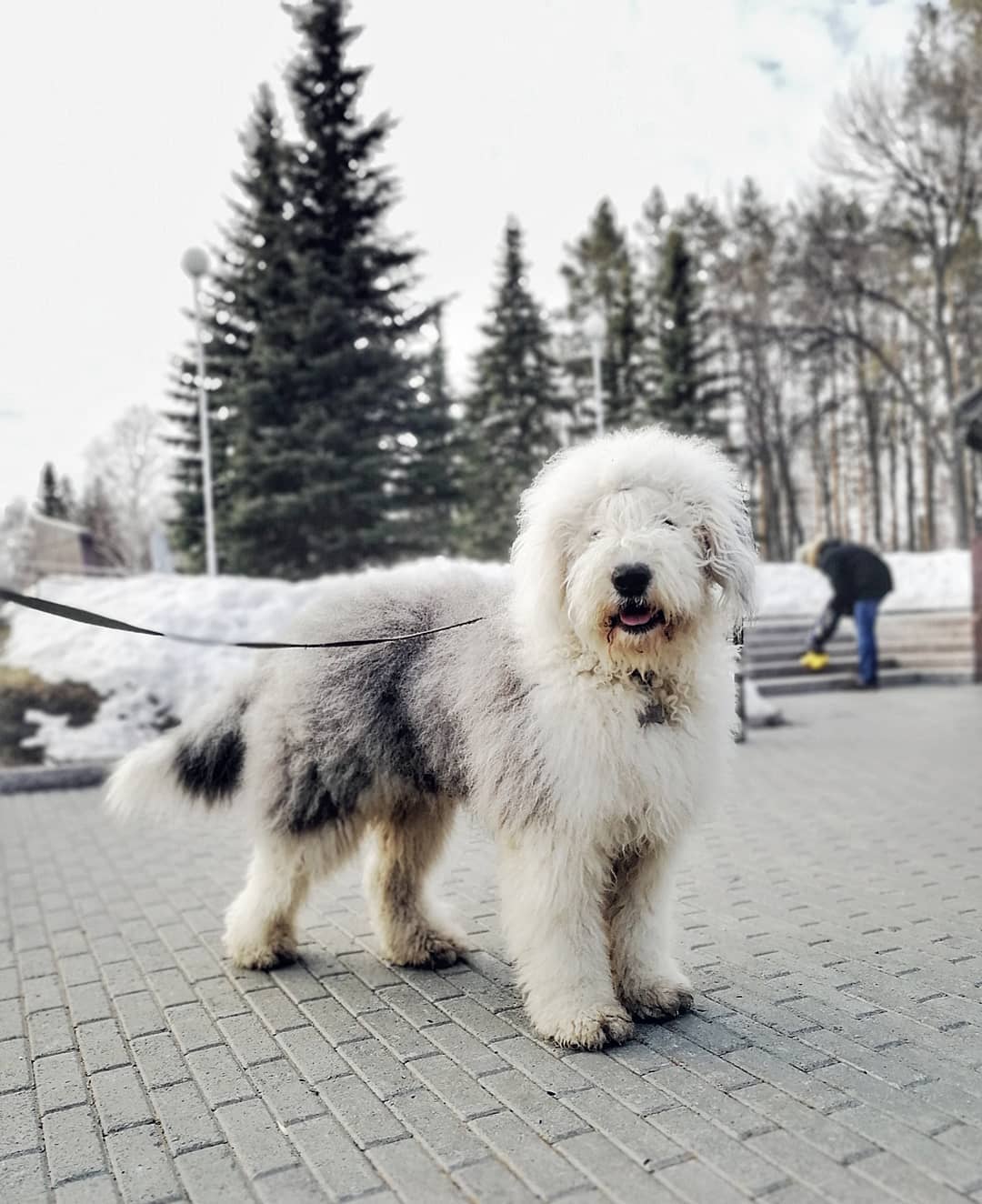
Males stand 22 inches tall and weigh 80 to 100 pounds. Females stand 21 inches tall and weigh 60 to 85 pounds.
The Old English Sheepdog is a playful, affectionate clown who delights in frolicking with his family and neighborhood children. In fact, adolescence in the OES often extends to about age three, and an adult OES will retain his playful demeanor well into his golden years.
An intelligent breed, the OES is a quick learner, always looking for something interesting and fun to do. He’s capable of performing numerous tasks, including herding, agility, obedience, and search and rescue.
This breed requires significant physical and mental exercise. He doesn’t enjoy being left alone for long periods of time and much prefers — in fact needs — to be in the company of his family.
A properly bred OES is good-natured and kind, and this is what makes him an excellent children’s companion and a super family dog. He’s sometimes called a nanny, a term of endearment that arises from stories surrounding the role he sometimes takes on within his family.
However, the OES is not known for being an assertive watchdog. He may bark when strangers come to his home — or he may not. Some OESs are highly protective, while others aren’t.
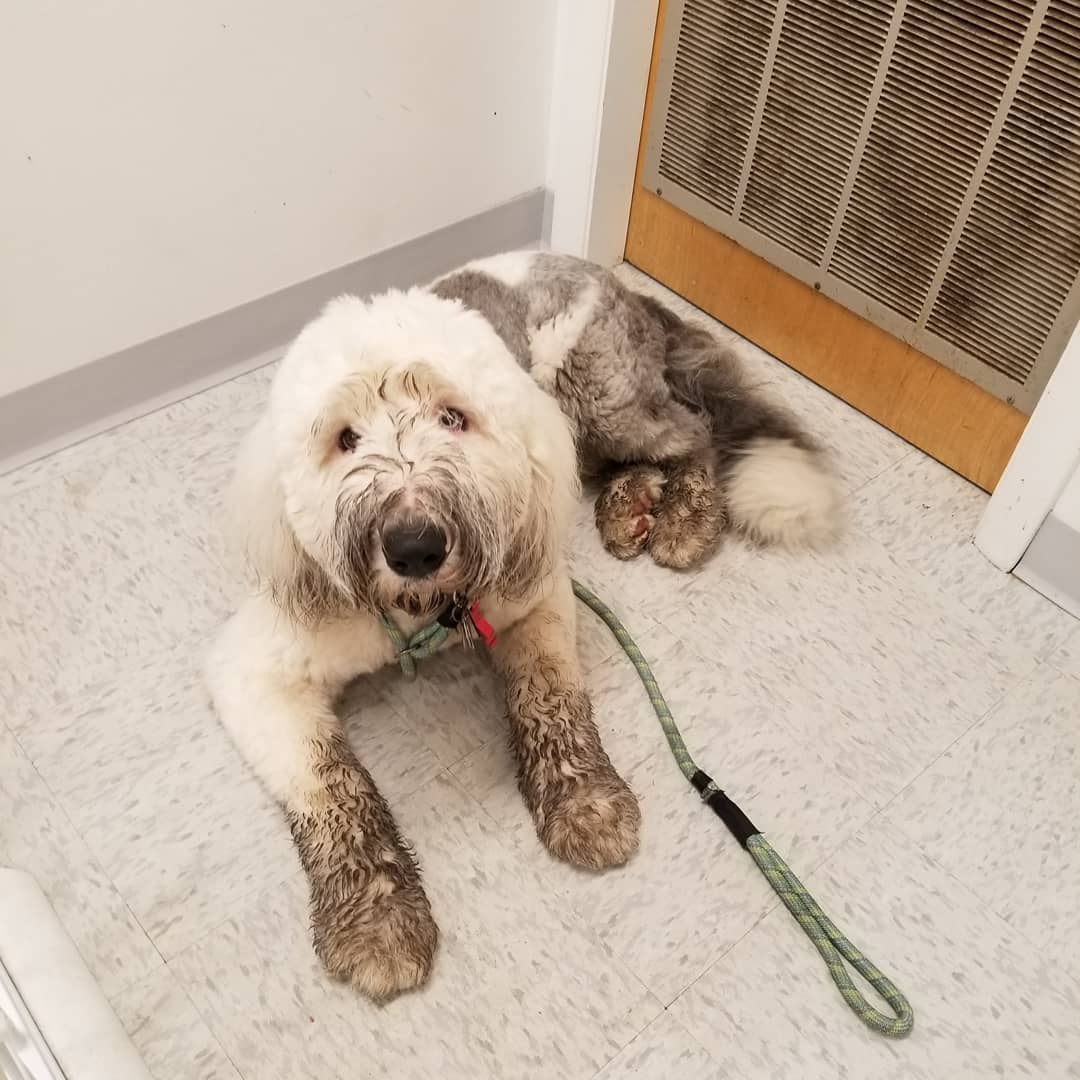
Old English Sheepdogs are generally healthy, but like all breeds, they’re prone to certain health conditions. Not all Old English Sheepdogs will get any or all of these diseases, but it’s important to be aware of them if you’re considering this breed.
- Canine hip dysplasia is a heritable condition in which the thighbone doesn’t fit snugly into the hip joint. Some dogs show pain and lameness on one or both rear legs, but you may not notice any signs of discomfort in a dog with hip dysplasia. As the dog ages, however, arthritis can develop. If you’re buying a puppy, ask the breeder for proof that the parents have been tested for hip dysplasia and are free of problems.
- Cataracts cause opacity on the lens of the eye, resulting in poor vision. The dog’s eye(s) will have a cloudy appearance. Cataracts usually occur in old age and sometimes can be surgically removed to improve vision.
- Progressive retinal atrophy (PRA) is a family of eye diseases that involves the gradual deterioration of the retina. Early in the disease, dogs become night blind. As the disease progresses, they lose their daytime vision as well. Many dogs adapt to limited or complete vision loss very well, as long as their surroundings remain the same.
- Hypothyroidism is caused by deficiencies of the hormone produced from the thyroid gland. A mild symptom of the disease may be infertility. More apparent signs are obesity, mental dullness, lethargy, and irregular heat cycles. The fur becomes coarse and brittle and falls out, while the skin becomes tough and dark. Hypothyroidism is treated with a daily thyroid replacement and usually requires lifelong treatment.
- Deafness is fairly common and can provide many challenges for both the dog and the owner. Some forms of deafness and hearing loss can be treated with medication and surgery, but usually deafness cannot be cured. Patience and time must be given to a deaf dog and there are many aids on the market, such as vibrating collars, to make life easier for you and the dog. If your dog is diagnosed with hearing loss or total deafness, take the time to evaluate if you have the patience, time, and ability to care for him properly.
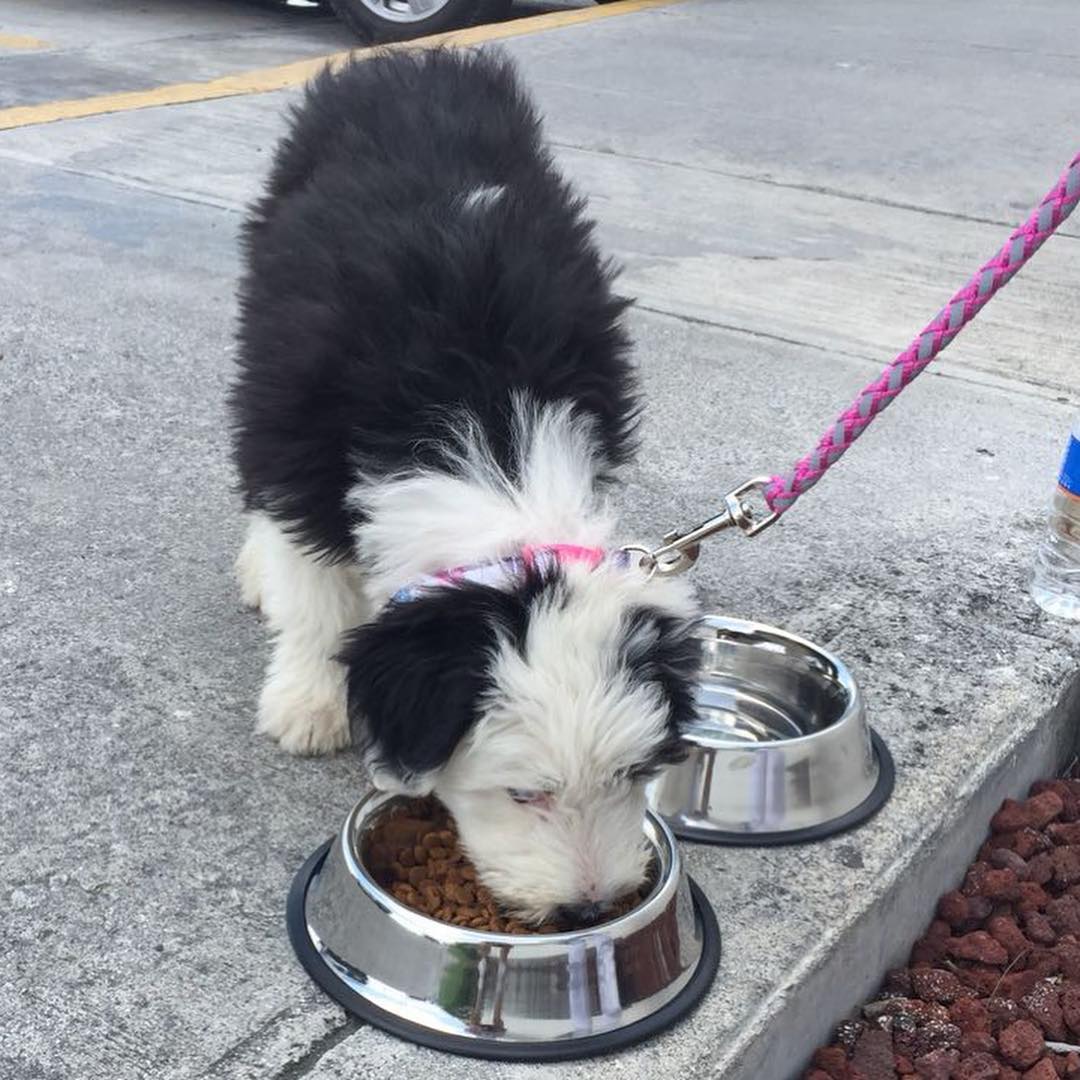
Because of his working origins, the OES likes activity. Today’s Old English Sheepdogs are very capable participants in sheepherding and agility trials, both of which demand a healthy and physically fit dog. Figure on one to two hours of daily exercise as part of the OES routine.
Of course, your dog’s needs will vary according to age. Pups have a lot of energy — so much so that they will use it to destroy your home if they aren’t kept busy with approved activities. On the other hand, older dogs may prefer to lie on the couch (taking up all of it) and need encouragement to exercise. It’s important to note that while the OES can readily adjust to less exercise, this isn’t particularly healthy for him.
However, cut back on outdoor exercise when the weather is hot. The dense undercoat of the OES is extremely warm, and the dog can overheat quickly and easily.
Obedience training is encouraged for all dogs, but especially for a large breed like the OES. The basic commands (“sit,” “down,” “come,” and “stay”) are important for everyday living with any dog, but add a wet and muddy OES coat in the mix, and you’ll realize that these commands are crucial. Luckily, the OES is very intelligent and learns quickly.
The OES does not always take confinement well, so if you crate train your OES puppy, must make sure that you do not leave him in the crate too long. He should be out with you when you are home; the OES is sensitive to being shut off from the family he loves.
During his first year, the OES grows from 1 pound to 60. When fully grown, he may weigh as much as 100 pounds. Due to this rapid growth, especially between the ages of four and seven months, they are susceptible to bone disorders. Take care to feed your OES puppy a high-quality, low-calorie diet that keeps him from growing too fast.
Additionally, he shouldn’t run and play on very hard surfaces such as pavement; normal play on grass is fine. Forced jumping or jogging on hard surfaces should be avoided until the dog is at least two years old and his joints are fully formed (puppy agility classes, with their one-inch jumps, are fine).
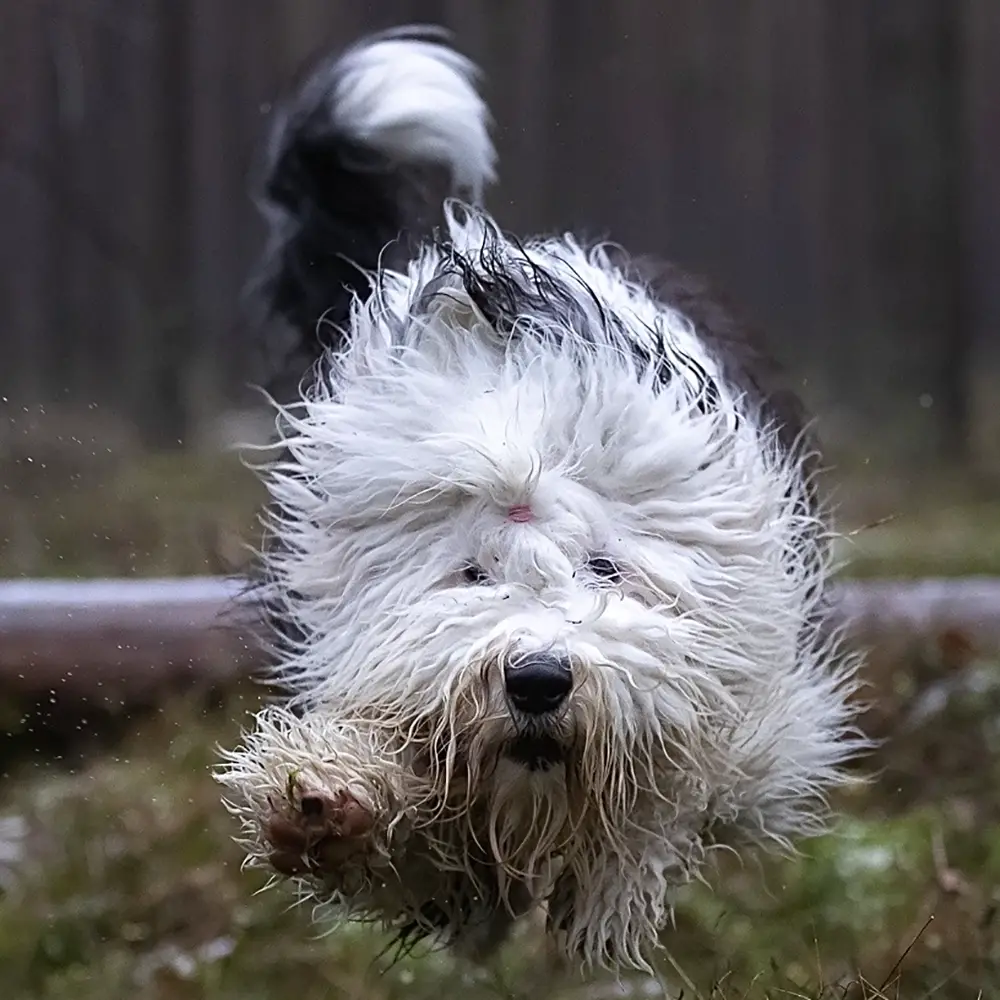
Recommended daily amount: 2.5 to 4.5 cups of high-quality dry food a day.
Note: How much your adult dog eats depends on his size, age, build, metabolism, and activity level. Dogs are individuals, just like people, and they don’t all need the same amount of food. It almost goes without saying that a highly active dog will need more than a couch potato dog. The quality of dog food you buy also makes a difference — the better the dog food, the further it will go toward nourishing your dog and the less of it you’ll need to shake into your dog’s bowl.
Overfeeding an OES is especially easy to do because the fluffy coat readily hides extra pounds. It is extremely important that you check your dog’s weight regularly and take care not to overfeed him.
For more on feeding your Old English Sheepdog, see our guidelines for buying the right food, feeding your puppy, and feeding your adult dog.
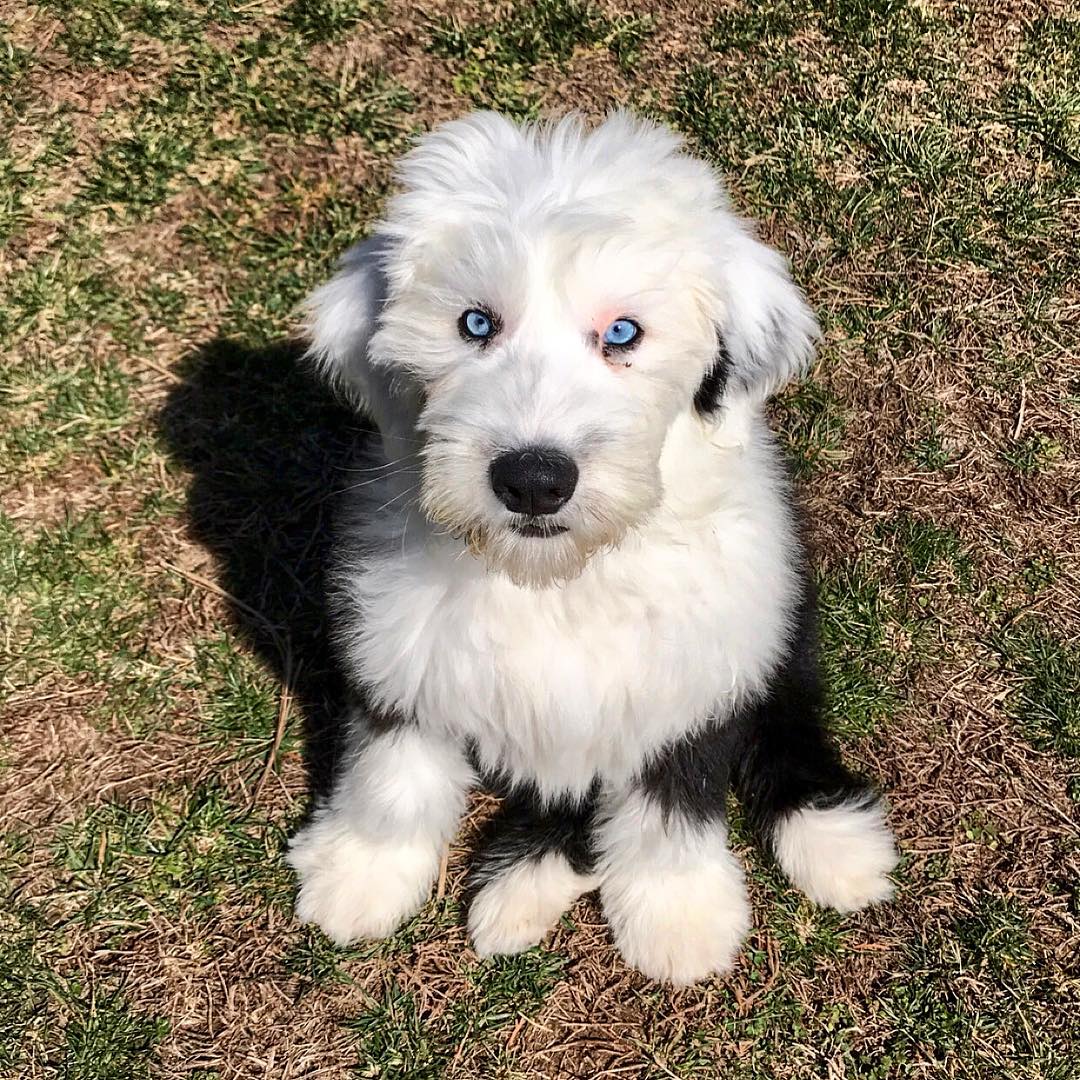
If you want a dog with big hair, the Old English Sheepdog is the one for you. This breed has hair galore: a profuse, shaggy coat that is neither straight nor curly. The breed has a double coat, with a textured outer coat and soft undercoat. Colors include gray, grizzle, blue or blue merle, brown, and fawn, usually mixed with white markings.
If you want a grooming challenge, try the OES. His coat is difficult to maintain; you will spend a minimum of three to four hours a week grooming him. If you’re new to the world of dogs, you’ll need help learning how to brush and comb your OES. The breeder can be helpful, and there are many quality grooming books and (better yet) videos on the market aimed at helping pet owners with this task.
The OES is a heavy shedder and requires daily brushing to remove dead hair and keep the coat free of tangles.
Some Old English Sheepdogs drool so much that the coat around their mouths turns yellow. If this happens, a regular washing, especially after meals, will help. Another method is to apply cornstarch to the beard. Once the cornstarch has completely dried, brush it out. This also works well when an OES has diarrhea.
As with all breeds, it is important to begin grooming the OES puppy at an early age. Making grooming a positive and soothing experience will ensure easier handling, both for you and for professional groomers, as your OES puppy grows into adulthood.
You’ll need to invest in a few tools to brush and comb your OES: a pin brush, coarse steel comb, and a slicker brush. Brushing should be a gentle process to avoid pulling and hurting the dog. It is important to always brush all the way to the skin, not just the top layer of coat, to remove any debris or hair that’s trapped in the undercoat. One tip for brushing is to spray the dog lightly with a detangler and/or conditioner before you brush.
Mats are a real danger for the OES, and they can lead to skin problems. They’re extremely difficult to remove and, in severe cases of matting, the dog will need to be shaved.
Besides brushing and combing out the coat, the OES needs bathing every six to eight weeks. The nails need to be trimmed once a month, and the ears checked once a week for dirt, redness, or a bad odor that can indicate an infection. Then wipe the ears out with a cotton ball dampened with gentle, pH-balanced ear cleaner. Regular toothbrushing with a soft toothbrush and doggie toothpaste will help prevent dental disease.
Many owners opt to have a professional groomer keep the OES coat in good condition (in addition to the regular brushing they perform themselves). This is expensive, and you must consider the cost when you think about buying an OES.
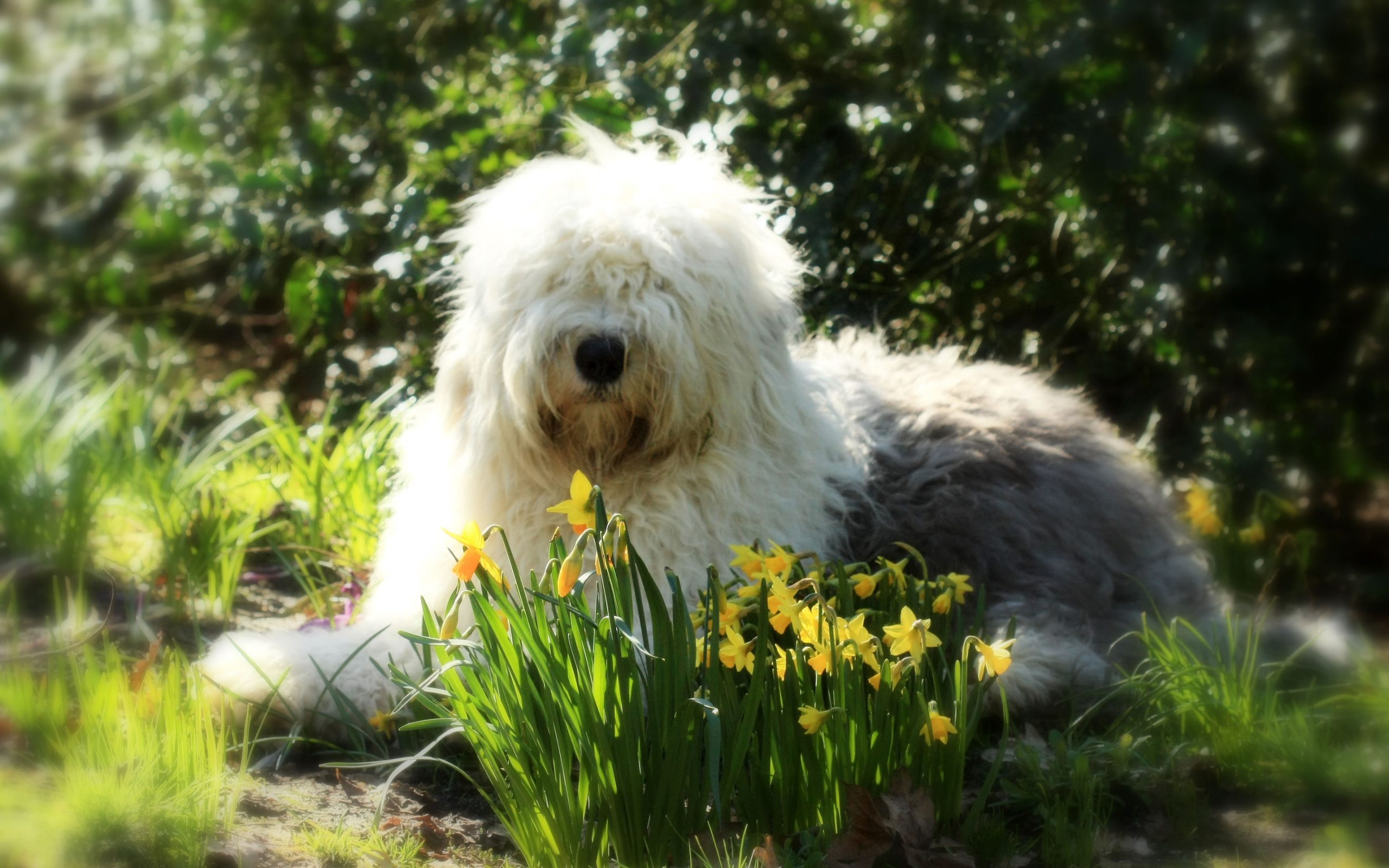
The well-bred and well-socialized Old English Sheepdog is a trustworthy children’s companion. Some say he will supervise and herd young children, keeping them in a particular area. Others say the OES acts as a means of support to the toddler learning to walk.
Unfortunately, there are some exceptions to the Old English Sheepdog’s role as a loving nanny, due to poor breeding that has resulted in ill-tempered and neurotic dogs. Buy only from a reputable breeder and ask to meet the puppy’s parents. And it is extremely important to note that children should never be left unsupervised with any dog, regardless of breed or temperament.
The good-natured OES is friendly with other dogs and pets, provided he is properly socialized and trained.
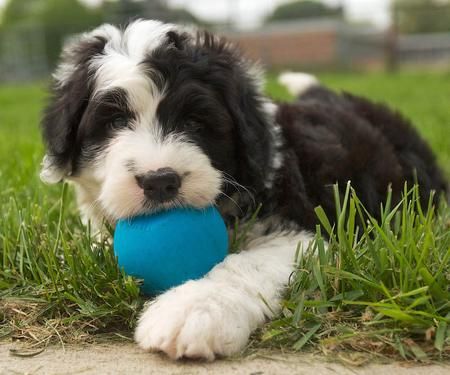
Old English Sheepdogs are often purchased without any clear understanding of what goes into owning one. There are many Old English Sheepdogs in need of adoption and or fostering. There are a number of rescues that we have not listed. If you don’t see a rescue listed for your area, contact the national breed club or a local breed club and they can point you toward an OES rescue organization.

